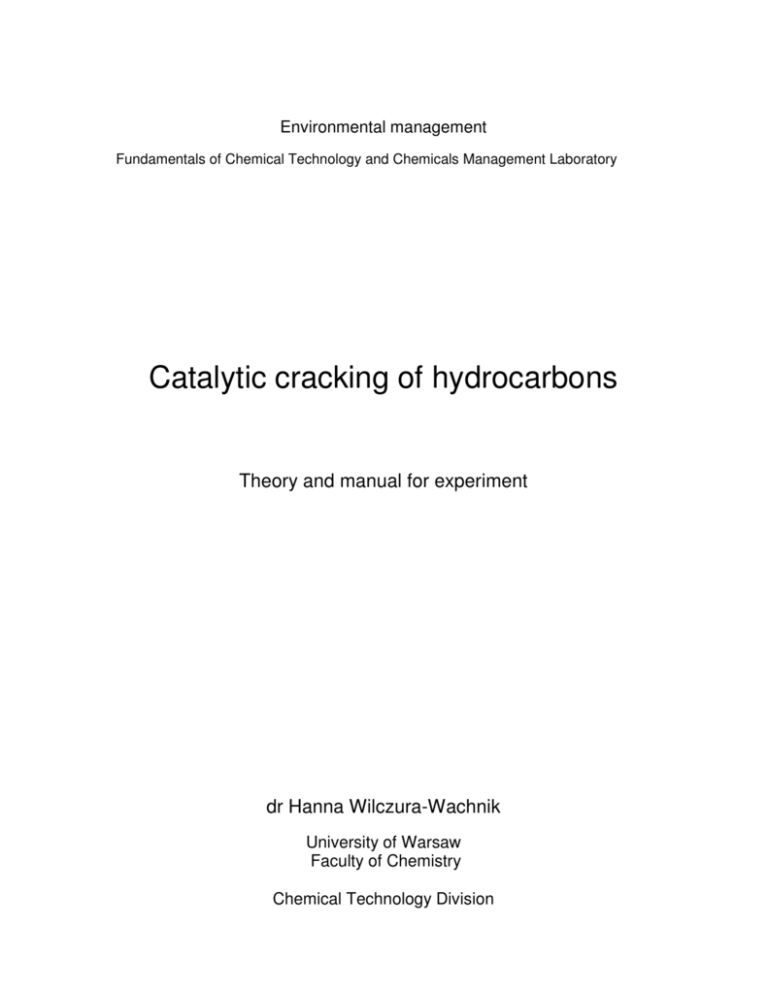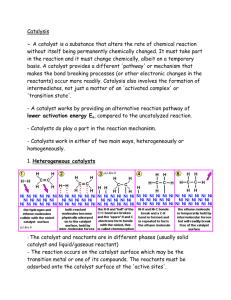Catalytic cracking of hydrocarbons
advertisement

Environmental management Fundamentals of Chemical Technology and Chemicals Management Laboratory Catalytic cracking of hydrocarbons Theory and manual for experiment dr Hanna Wilczura-Wachnik University of Warsaw Faculty of Chemistry Chemical Technology Division Introduction – Theoretical Background Nearly all biological reactions and most industrial synthesis require catalyst. Presently, catalysis is the most important technology in environmental protection, i.e., the prevention of emissions different toxic chemicals. A well-known example is the catalytic converter for automobiles. The term “catalysis” was introduced by Berzelius in 1836. Describing various reactions he found that catalysts posses special powers that can influence the affinity of chemical compounds. After many years in 1895 Ostwald proposed the following definition of catalysts: “a catalyst accelerates a chemical reaction without affecting the position of the equilibrium”. Additionally it was assumed that the catalyst remained unchanged in the course of the reaction. This definition is still valid today. Now it is know that during the catalytic process between reactants and catalyst the chemical bodings are formed. The catalysis is realized as a cyclic process with the following steps: 1. the reactants are bound to one form of the catalyst, 2. the intermediate catalysts-reactant complexes are formed (usually the intermediate catalyst complexes are highly reactive and difficult to detect), 3. the reaction performs, 4. the products are released from another form of catalyst, regenerating its initial state. The simple catalytic cycle is shown in Figure 1. Figure 1. Catalytic cycle scheme 2 The suitability of a catalyst for an industrial process depends mainly on the following properties: - activity - selectivity - stability. Depending on industrial priority mentioned above properties can be ordered as follows: selectivity>stability>activity. Such order is a consequence of today’s preference according to which optimizing of existing processes is more preferable than developing new ones. The catalyst definition assumes that, an ideal one would not be consumed during reaction, but this is not the case in practice. Usual the catalyst undergoes chemical changes, and its activity as a function of time becomes lower. Such activity decreasing is called catalyst deactivation. Deactivated catalyst must be regenerated or if it is necessary replaced. Activity of given catalyst is a measure of how fast reaction (or reactions) proceeds in the presence of the catalyst. The reaction rate v is calculated according the following equation: ν= ms [mol L-1 h-1 or mol kg-1 h-1] c∗t where: m s - a converted amount of substance of a reactant [mol] c - a catalyst volume or mass [L] or [kg] t - a time [h]. Another important property of catalysts apart from accelerating reaction is the influencing on the selectivity of chemical reactions. The catalyst selectivity involves obtained different products from a given starting compound by using different catalyst system. It means that employing two different catalysts is possible obtaining completely different products from the same starting material. In Figure 2 are given samples of different products obtaining from the same material – synthesis gas using different catalysts. 3 Figure 2. Synthesis gas products depending on used catalyst In industrial practice this possibility reaction control sometimes is more important than the catalytic activity. The selectivity S of a reaction is calculated as a fraction of starting material A that is converted to the product B. Selectivity S can be calculated according to the equation: in reaction A B S= [m A(b ) − m A( end ) ] [m A(b ) − m A( end ) ] totally in whole process Catalyst stability is a third property important from industrial point of view because the chemical, thermal and mechanical stability of catalyst determines its lifetime in industrial reactors. The total catalyst lifetime is of crucial importance for the economics of a technological process. There are numerous factors influencing on catalyst stability. Among many there are: decompositions, coking and poisoning. Catalyst time stability depends on reaction conditions including reactants purity. Usually decreasing of catalyst stability is determined by measuring activity or/and selectivity as a function of time. Catalyst deactivation can be reversible or not depending. Reversibly deactivated catalyst can be regenerated. Usually it is done in a separate process. Catalyst classification There is not general catalyst classification because variant criteria can be taken into account. Usually there are: aggregation state, structure, composition and 4 area of application. The most popular classification is according to the state of aggregation in which catalysts act. There are: heterogeneous, homogeneous and enzymatic catalysts (Scheme 1). Scheme 1. Catalysts classification Heterogeneous and homogeneous catalysts belong to the wider used in industry. Enzymatic catalysts are employed mainly in pharmaceutical and cosmetic technologies. Generally, the main characteristic feature of heterogeneous catalytic systems is that they are in solid state and in a different phase than entrance compounds and reaction products. The most important advantages of these catalysts are a higher selectivity and reparability comparing to homogenous ones. The characteristic features of both catalysts types are compare in Table 1. 5 Table 1. Comparison of homogeneous and heterogeneous catalysts features Enzymes are classified as a separate class of catalysts. They have significant advantages (activity, selectivity, specificity), and disadvantages (costs) comparing to heterogonous and homogeneous catalysts. Enzyme-catalyzed reactions are very expensive. Enzymatic catalysis is used mainly in pharmaceutics, dairy and food industries. Till now the main technologies preferably use heterogeneous catalysts or homogeneous. Depending on state aggregation catalyst are gases, liquids and solids. Industrially important are liquid and solid catalysts. It is worth to mention that around 75% of all chemicals are produced in processes employing catalysts. For example the production of synthetic fibers, plastics, pharmaceutics, agents, resins, cropprotection, and pigments required catalytic processes. Moreover in such technologies as the crude-oil processing and petrochemistry catalysts are necessary on purification stages, refining and other. Catalysts have been used in inorganic technologies like synthesis of sulfuric acid, the conversion of ammonia to nitric acid. Finally, environmental protection measures such as automobile exhaust control, and purification of off-gases from power stations and industrial plant would be inconceivable without catalysts. Recently many selective catalysts like 6 multicomponent oxides and metallic catalysts, zeolites and metal complexes have been developed. All catalytic process can be classified according to reaction mechanism as: - oxidation-reduction reactions (redox reactions): hydrogenation, dehydrogenation, oxidation. The typical catalysts: metals, semiconducting metal oxides and sulfides. - acid-base reactions: hydrolysis, isomerization, cracking, alkylation. Typical catalysts: the Bronsteds and Lewis’s acids and bases, oxides: aluminium, magnesium, and aluminosilicates. - reactions with coordinative mechanism: polymerization, oligomerization, carbonylation, hydrogenation, hydroformylation. Typical catalysts: metals complexes (usually transition metals) bimetallic systems. Hydrocarbon cracking is the process whereby large and heavy hydrocarbon molecules (long-chain hydrocarbons) are broken down up into simpler and smaller bits as light hydrocarbons (short-chain hydrocarbons) by the breaking a carboncarbon bonds in cracking stock. Generally, the rate of cracking and the final products strongly depend on the temperature, pressure and presence of catalysts. Hydrocarbons cracking can be achieved into two ways: - without catalyst by using high pressures and temperatures (named pyrolysis or thermal decomposition) - in the presence of a catalyst by using lower temperatures and pressures (named catalytic cracking). The main source of large hydrocarbon molecules is the naphtha fraction (as a liquid) from the fractional distillation of crude oil in refinery. This fraction after revaporisation can undergo a cracking. In modern oil refinery industry a commonly used process is a catalytic cracking in a fluid phase. This process employing a powdered catalyst was first time used in around 1942 at refineries in the U.S. On the beginning process was based on low activity alumnina catalyst and a reactor where the catalyst particles were suspended in a flow of feed hydrocarbon as a fluidized bed. 7 Alumina as a stable catalyst bed is still used in student’s laboratories concerning hydrocarbons cracking process. In new designs a very active zeolite-based catalyst are used. These catalysts characterize a short-contact time to cracking stock. Usually pre-heated feed is sprayed into the base of the riser via feed nozzles where it contacts very hot ( 650OC800OC) fluidized catalyst. So hot catalyst vaporizes the cracking stock and catalyzes the cracking reaction of hydrocarbons. Because of extremely high activity of this type catalyst the contact time catalyst-hydrocarbon is around a few seconds (sometimes shorter) and then the mixture is separated via cyclones. The catalyst-free cracking products stream is routed to fractionations columns for separation into gas and liquid fractions. Usually there are: fuel gas, LPG (Liquefied Petroleum Gas), gasoline, naphtha, light cycle oils used in diesel and jet fuel, and heavy fuel oil. During reaction catalyst reduces activity and selectivity because of a coke depositing on the catalyst surface. This damaging process is called catalyst deactivation and catalyst is called spent. The spent catalyst (after separation from the cracked hydrocarbon vapors via cyclones) is routed to a stripper where a hydrocarbons remaining in the catalyst pores are removed. After that deactivated catalyst flows into a fluidized-bed regenerator where in air atmosphere (in some cases with oxygen) a coke adsorbed on catalyst is burn off. As a result of burning process the catalyst activity is restored and the catalyst is regenerated. The burn off process as extremely exothermic produces a huge amount of heat which can be consumed in the next reaction cycle for pre-heating feed (cracking is an endothermic reaction). The regenerated catalyst is routed to the base of riser and the cycle of reaction can be repeated. The FCC (Fluidized Catalytic Cracker) is a very important source of olefins (C3 – C4) (LPG) and isobutane, isobutene which are the essential feeds for the alkylation process and polypropylene production. Except fluid catalytic cracking (FCC) as catalytic cracking processes are classified also moving-bed catalytic cracking and Thermofor catalytic cracking (TCC). Generally each catalytic cracking process consists of three basic steps: • reaction – during which cracking stock reacts with catalyst, • regeneration – during which catalyst is reactivated by burning off coke, 8 • fractionations – during which stream of cracked hydrocarbon is separated into fractions containing various products. During the hydrocarbons catalytic cracking there is no preceding any single unique reaction. When the hydrocarbon molecules are broken up in a random way as a product a mixture of shorter hydrocarbons chains is expected. In addition except, catalytic cracking reactions of isomeryzation, cyclization, polymerization, dehydrogenation and others are also possible. The mechanism of catalytic cracking of hydrocarbons is ionic. An example of such, on zeolite type catalyst having a strongly acidic Brönsted’s centers is given below: (Zeolite is a synthetic aluminosilicate with formula: Me2/nO·Al2O3·nSiO2·pH2O n=1, Me: Na, K, Ag, H,... n=2, Me: Mg, Ca, Ba,...). Depending on which reaction (β-splitting or isomerization) dominates the main products are different. In case of β-splitting domination the products contain mainly alkenes (propene, butane). In case of isomerization domination branched hydrocarbons arise. It is worth to note that except of reactions mentioned above there 9 are possible reactions: polymerization, cyclization, and aromatization. As a result catalysts are deactivated and regeneration procedure is realized. 10 Manual for experiment Exercise aim The main goal of this experiment is catalytic cracking of chosen aliphatic hydrocarbons (hexadecane, dodecane etc.) and studies an influence of temperature, time and cracking stock dosage speed on the final products. In the experiment molecular sieves (zeolite 13X) and/or Al2O3 are used as a catalyst. The reaction products (liquid and gases) are analyzed with gas-liquid chromatography using Hewlett-Packard GC 6890. Installation description A schematic diagram of device is presented in Figure 1. The process consists of two steps: reaction and catalyst regeneration. The reaction is performed at isothermal conditions in reactor (1) filled with catalysts (4,4g zeolite 13X). Temperature inside the catalyst bed (2) is measured with thermocouple (3). Control unit (11) is a temperature regulator (involves on temperature programming). Hydrocarbon is dosing with a stable rate into reactor with calibrated syringe using infusion pump (4). Reaction products passing through condenser (8) cool down and finally liquid products condensate in receiver (9). Element (15) is filled with “dry ice+acetone”cooling mixture and all residual products are freezing out there. Gaseous products flows through container (6) and, after through gas meter (7). Washer (16) filled with paraffin oil indicates gas flow. Air pump (5) doses air into reactor during catalyst regeneration. Gas cylinder (14) contains inert gas (Ar or N2) which if necessary for reaction products removing from catalyst bed and at final step of catalyst regeneration for air removing is used. During the second step – catalyst regeneration the pump (5) doses air into reactor. The mixture carbon oxide and carbon dioxide flows to afterburner (10) where reaction carbon oxide oxidation to carbon dioxide with Cu as a catalyst performs, and next CO2 flows to absorber (19) filled with sodium hydroxide solution (NaOH) where sodium carbonate (Na2CO3) arises as a product. Peristaltic pump (19) helps in gases transportation between reactor through afterburner to absorber. 11 Figure 1. Installation scheme. A,B,C,D,E,F cranes; 1- flow reactor; 2- catalyst bed; 3 – thermocouple; 4- infusion pomp; 5- air pomp; 6- gaseous-products container; 7gas meter; 8- Liebig condenser; 9- liquid products container; 10- afterburner COCO2;; 11and 11a- temperature units control; 12- cooling bath; 13- afterburners’ products transport line; 14- inert gas (Ar or N2) cylinder; 15- “dry-ice” + acetone container; 16- oil washer; 17- gases outlet; 18- peristaltic pump; 19-absorber. Experiment steps 1. Turn on air pump (5) and temperature control unit (11) set-up 600oC for catalyst regeneration (30minutes). 2. Weight products receiver (9). 3. Decrease catalyst temperature to 450oC – 570oC according to instructor suggestion and purge catalyst bed with argon. 4. Infusion pump (4): set dosing speed on suitable value (proposed by teacher). 5. Fill syringe with dodecane (or other raw material) and place needle through membrane into reactor. 6. Connect receiver (9) with Liebig condenser (8). 7. Note gas meter (7) value. 8. Fill cooling bath (12) with “dry-ice+acetone” mixture. 9. Start dosing dodecane (pump “on”) and note time. 12 10. Reaction time suggests instructor. 11. Time over, turn off dosing raw material, take out needle. 12. Note gas meter (7) value and disconnect gaseous products container (6). 13. Purge catalyst bed with Ar (gas cylinder 14). 14. Disconnect liquid products receiver, and when its temperature become to room temperature weight it. 15. Make glc of liquid and gaseous products. 16. Obtained results note in suitable results table. 17. Regenerate catalyst bad (30minute) in an air flow. 18. Increase temperature till 220oC in afterburner (10) using temperature control unit (11a). 19. Fill absorber (19) with 0.1M NaOH solution (the volume suggests instructor). 20. Turn on peristaltic pump (18). 21. Using Warder’s method Na2CO3 contents is determined. 22. Regenerate catalyst and eventually perform process under different conditions (change temperature, raw material dosing speed,) according to points from 3 till 19. Note! During experiment the crane A,B,C,D,E,F right position should be consulted with instructor. The Warder’s method* description The determination of sodium carbonate contents in 0.1MNaOH solution with Warder’s method is realized through acid titration (0.1MHCl) using phenolphthalein and methyl orange as indicators. The sample of titrated solution should be cooled (in a mixture ice with NaCl) because of CO2 loss limitation. Additionally the burette terminal position should be close to solution surface. The first titration in the presence of phenolphthalein is till solution discolouration (whole amount of NaOH and half of Na2CO3 is titrated). Sodium carbonate passes to sodium bicarbonate according to reaction: Na2CO3 + HCl ===> NaHCO3 + HCl ph = 8.3 Next, to the solution a methyl orange is added and titration (with 0.1MHCl) continues till the first colour change (from yellow to orange) as a result of the reaction: NaHCO3 + HCl ===> NaCl + H2O + CO2 13 If during first titration (in the presence of phenolphthalein) a [mL] of 0.1M HCl was consumed, and during second titration (in the presence of methyl orange) b[mL] of 0.1MHCl, than the Na2CO3 amount (in grams) can be calculated according to equation: X = b • CM • 0.106 where: CM – HCl molar concentration [ mmol/mL] 0.106 - Na2CO3 molar mass [g/mmol] and finally, the carbon contents in sodium carbonate should be calculated. * J.Minczewski, Z.Marczenko „Chemia analityczna. Analiza ilościowa .” PWN 1973, Vol. 2 page 224 The final equation according with the amount of the Na2CO3 amount (in grams) is calculated is given as: X = b • CM • 0.106 • 50 On the end, the amount of coke that has been adsorbed on catalysts should be calculated. Experiment report should be prepared according to pattern attached to manual and contained: - An aim of experiment, - an experiment brief description, - glc results description and interpretation, - a table containing obtained and calculated data, - Sankey diagram (if necessary prepared on basis of process mass flow balance) with suitable scale and stera legends, - results discussion, and comments, - conclusions ( among, if the aim of experiment has been achived), - students remarks and suggestions if there are some (for example how to improve some steps of experiments). A results sheet signed by instructor should be attached. 14







